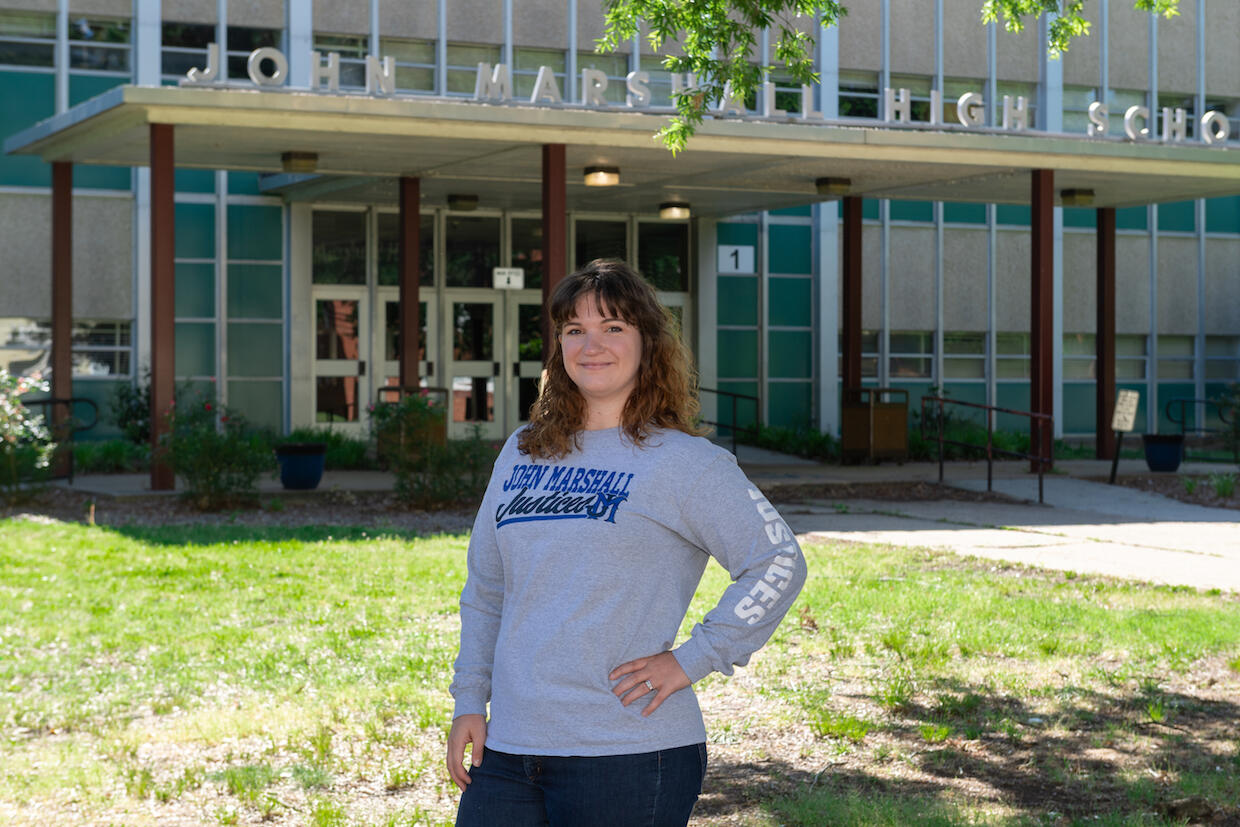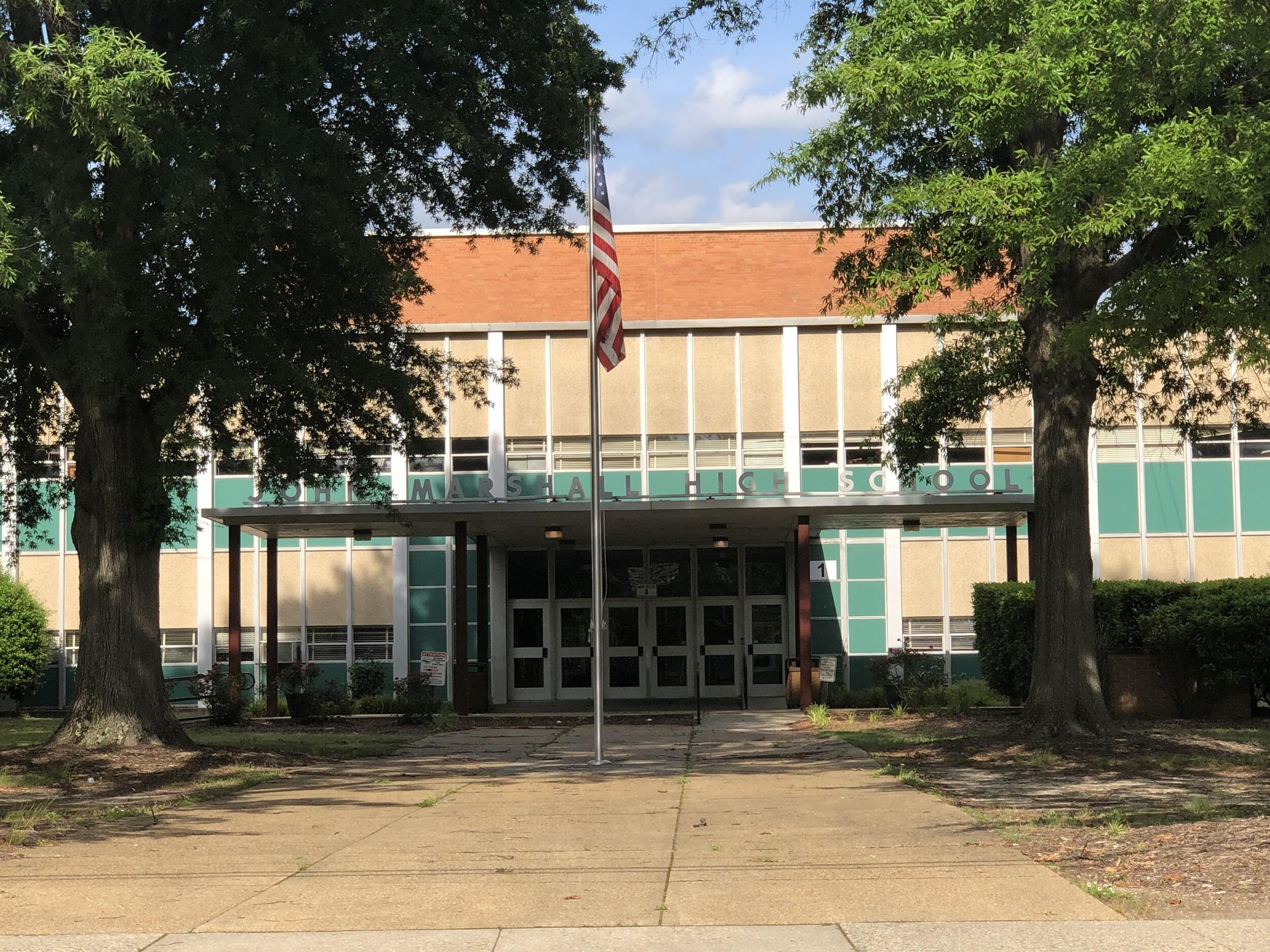
June 8, 2020
VCU English student, a teacher at Richmond’s John Marshall High School, digs into the school’s past
Sara MacRae’s research project for her master’s degree is a study of the history of the school and its current site, which was once a smallpox quarantine zone following the Civil War.
Share this story
When it came time to choose a final research project for her master’s degree, Sara MacRae found inspiration in her job as a teacher at John Marshall High School. She decided to study the history of her school — which opened in 1909 — and its current site, which was part of the extended grounds of an open-air hospital for people with tuberculosis at the turn of the century and a smallpox quarantine zone following the Civil War.
“I’ve always been fascinated with history and the way that it is intertwined with English,” she said. “I was inspired by how much history is in the building and how little my students knew about the school’s role in history.”
Richmond has played a significant part in U.S. history and MacRae realized her school could be a lens through which parts of the city’s story — such as racial segregation, public education, the development of neighborhoods and public health — could be understood.
“Historically, schools are the center of the community,” she said. “But [students] are often frustrated because they feel like they get the same narrative of history three times in their K-12 education. This project was born out of a desire to build a connection for my students between where they live and our school to a larger historical narrative.”
MacRae earned her undergraduate degree from VCU from the Department of English in the College of Humanities and Sciences and went on to earn a master’s degree in teaching from the School of Education. She began teaching at John Marshall in 2015 and has been working toward her second master’s over the past couple of years. She’ll graduate this summer with her master’s in English.
I’ve always been fascinated with history and the way that it is intertwined with English. I was inspired by how much history is in the building and how little my students knew about the school’s role in history.
As part of her orientation at John Marshall, MacRae and the other new teachers were encouraged to look through a decade of the school’s yearbooks to create a timeline of major events. That exercise was a spark that would eventually lead to her research into the school’s history.
“The differences in the centennial history of John Marshall was astounding; each decade of yearbooks were indicative of their era. Notably, the yearbooks from 1950-1980 were a telling history in desegregation, white flight and integration,” MacRae writes in her report, “Researching Richmond: A Detailed History of Richmond City Public Schools, John Marshall HS, and the Land on which it Stands.”
“As I examined the history of these yearbooks, I began to wonder: When did John Marshall transition? Why do families in historically white neighborhoods not know their zone schools? When did the achievement gap widen? Did the achievement gap exist before the standardization of education — did it broaden or narrow after standards-based education infiltrated public schools? When did a historically white school become predominantly black?”
The research was also inspired by a course MacRae took in fall 2018, “Literature and Culture of the Early Modern Atlantic World,” taught by Mary Caton Lingold, Ph.D., an assistant professor of English. The class read about the colonization of America and Atlantic slavery, helping students understand the literary culture of the era and the power of historical narrative.
“Sara became interested in bringing what she was learning to her own classroom at John Marshall High, and that led to her creative idea to explore the long history of the school itself,” said Lingold, MacRae’s adviser. “She was curious, for instance, about the land that the school now stands on, which is very near the site of Gabriel Prosser’s rebellion and the plantation where he was enslaved.
“Her original questions led her on an extraordinary journey,” Lingold said. “After the class ended she wanted to take the project much further, and so she embarked on two directed studies during which time she researched in local archives and scoured the web and history books for information.”
John Marshall High School through the years
The original John Marshall High School, also known as “The People’s University,” was located at Eighth and Marshall streets. It was the first official public school in Richmond, MacRae found, preceding the national wave of compulsory public education in the 1920s.
The original building notably served as an emergency hospital during the 1918 flu pandemic.
“The building closed to students during October and November. Volunteers tore up desks and transformed the school into an emergency facility in less than a week,” MacRae wrote. “The hospital provided care to over 200 patients during its brief installation.”
The school was racially segregated, and mostly had white male students until the 1940s, when more white female students enrolled.
The original school eventually outgrew its space and was razed in 1961. Students protested the demolition, but the city tore it down and redeveloped the site as the John Marshall Courthouse complex, which is still there today.
The new John Marshall High School opened at 4225 Old Brook Road in September 1960 and was racially segregated until the 1970s.

The site itself had previously served various purposes for Richmond. Its first documented use was as “City Farm,” which provided food for the local jail and for poor residents of the city’s almshouse. In the 18th and 19th centuries, it served as smallpox isolation wards.
“Unlike many areas nationally, the city of Richmond served black and white patients, although the level of service certainly differed,” MacRae wrote. “In 1905, the property constructed a small house to hold white patients, and relegated black patients to an older, less sound structure. However, both races eventually ended up in the same building as the structure for the black patients collapsed.”
The site was also adjacent to what was known as Pine Camp Tuberculosis Hospital and alternatively as the Pine Camp Sanitarium. Richmond acquired the property in 1916 and it was one of several sanitariums in the city’s Northside.
“Dozens of patients lived here for six to 24 months while suffering from long-term illnesses. As antibiotic treatments developed and science advanced health care, the population of the hospital decreased,” she wrote. “The facility finally closed in 1957 when the last few patients were transferred to the City Home. Since the city no longer needed the area for health care, two school buildings and a recreation center took the place of the former sanitarium.”
‘It shows how connected we all are as public educators’
MacRae’s research involved digging through the school’s yearbooks and newspaper archives, as well as visits to the Library of Virginia for geological surveys and urban planning documents, and local courthouses to search land records.
“At first I couldn’t find specifically what I needed for 4225 Old Brook Road and I couldn’t figure out why. But I realized it was because I was looking at Richmond, [whereas] that area was in Henrico County at the turn of the century,” she said.
Her courthouse records research was derailed by the pandemic, but she is hoping to return to it as soon as it is safe. She is also considering launching an oral history project about the school in which she would interview former students, teachers and community members from 1960 to today.
Lingold said she has been astounded by MacRae’s dedication to the project and her students.
“Although she has been working full time in the classroom, she has managed to research on nights and weekends and in the summer months to bring this project to fruition,” Lingold said. “Sara’s efforts to bridge her own graduate studies with her high school English classroom shows the interconnectedness of teaching and learning across the community. I love nothing more than to teach teachers because the impact is broad and it shows how connected we all are as public educators. As a Northside resident and parent of a Richmond Public School student, I feel especially proud and connected to Sara’s work on the history of John Marshall High, ‘The Joy and Pride of Northside.’”
Subscribe to VCU News
Subscribe to VCU News at newsletter.vcu.edu and receive a selection of stories, videos, photos, news clips and event listings in your inbox.









